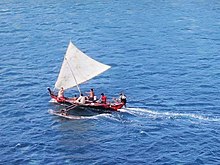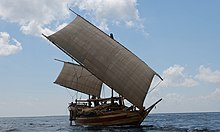Ghurab

Ghurab or gurab is a type of merchant and warship from Nusantara archipelago. The ship was a result of Mediterranean influences in the region, particularly introduced by the Arabs, Persians, and Ottoman.[1]
Etymology[]
The name of this ship include gorap, gorab, gurab, ghurap, gurap, and benawa gurab. The name comes from Arab word "ghurāb" or "ghorāb", meaning raven or crow. The word also mean "vessel" or "galley" in Arabic or Persian.[2][3] The word benawa or banawa comes from kawi Javanese language, which means boat or ship.[4] In old Javanese language and Malay language the meaning is more or less the same.[5]
Description[]

Ghurab is a medium to large-sized Malay trading vessel. They can be converted into a warship by adding swivel guns (rantaka). Early ghurab was galley-like, it has oars in addition to sails.[6]
The larger ghurab had 2 guns pointing fore (bow-chaser) and 15 on the each side, with the total of 32 guns. The smaller ones carried 2 fore and 10 on each side (22 guns).[7] The ghurab has projecting stern.[8] H. Warington Smyth, in 1902 described a large 2-masted trading gurap built of giam wood. The dimension is as follows: 300 ft (91.4 m) long, 30 ft (9.1 m) wide, 20 ft (6.1 m) depth, 11 ft (3.4 m) freeboard. The capacity was 100 koyan (241.9 metric tons), with 100 ft (30.5 m) mainmast, crewed by 30 men. The vessel is using fore-and-aft sail made with cloth, with yard and gaff topsail.[9]
Role[]
Ghurab is used as trading ship as well as warship. One of the earliest account of ghurab is from 15th century, being mentioned in Hikayat Hang Tuah. Two pencalang and two ghurab were used by Majapahit to send a letter and gifts to improve relationship with Malacca. The ghurabs were said to be "in the style of the Arabs' (ship)".[10]
Until early 16th century main merchant and warship of the Javanese was the jong, but since the mid-16th century the maritime forces of the archipelago began to use new types of agile naval vessels that could be equipped with larger cannons: In various attacks on Portuguese Malacca after the defeat of Pati Unus, they no longer used jong, but used lancaran, ghurab and ghali.[11]
In 1515, Bintan attacked Kampar and Portuguese Malacca with 24 lancaran and 6 large ones called gurab.[12]

The Hikayat Aceh states that the Acehnese sultanate had 120 large ghurab in the 1570s. The state ghurab (ghorab istana) of Aceh, Daya, and Pedir is said to carry 10 meriam, 50 lela, and 120 cecorong (not counting the ispinggar). Smaller ones carry 5 meriam, 20 lela, and 50 cecorong.[13]
In 1624, war fleet of the Mataram Sultanate numbered 2000 vessels consisted of gurab and small perahu.[12] At 22 August 1628, 59 goraps of Sultan Agung's navy appeared at Batavia, unloading provisions for the Siege of Batavia.[14]: 376
Ships with similar name[]

There are several type of ships historically also called as ghurab or similar names. The description and construction of each vessels, however, isn't necessarily the same.
Mediterranean[]
According to Al-Maqrizi (1441 A.D.), ghurāb of the mediterranean sea were huge war galleys. According Ibn Mammati (1209 A.D.), these ships had 140 oars. Al-Maqrizi refers to both Muslim and Christian galleys as ghurāb.[15] Reinaud said that ghorāb was the name given by Moors to true galleys. Ubaldo (1181) tells about ghurāb as vessels sailing to and from Tripoli.[16]
Genizah letters mentions about cargo ghurābs that sailed from the Maghrib and Sicily as well as those operating on the Nile, carrying shipments of carob and flax.[17]
Indian Ocean[]
Indian Ocean ghurāb, which often appears in the records of 17th century was native Arab-Persian and Indian cargo, pirate, and war vessels.[18]
Abu Shama ca. 1266–1267, in Kitab al-rawdatayn fi akhbar al-dawlatayn, wrote about ghurāb:[3]
"They sail by their masts (i.e. the sails); they (look like) quivers, but penetrate like arrows . . . It is no surprise that they are called ghurābs because they spread their wings like those of a dove"
Sidi Ali in 1552, describes ghurābs as “great (rowing) vessels”; he also says that smaller ghurābs are “galliots with oars”.[19]
Grab of Malabar coast is a vessel that was generally of shallow draft, and broad in proportion to its length. Size could range between 150 and as much as 500 tons (bm).[18]
See also[]
- Lancaran, backbone of Malay fleet before mediterranean influence came
- Jong, large sailing ship from Nusantara
- Lancang
- Penjajap
- Ghali
- Kelulus, Javanese rowing ship
References[]
- ^ "I.1 The Maritime World :: Sejarah Nusantara". sejarah-nusantara.anri.go.id. Retrieved 2020-01-23.
- ^ Jones, Russell (2007). Loan-Words in Indonesian and Malay. Yayasan Pustaka Obor Indonesia. ISBN 9786024331740.
- ^ a b Agius, Dionisius A. (2008). Classic Ships of Islam: From Mesopotamia to the Indian Ocean. Leiden: Brill. ISBN 9789004158634.
- ^ Maharsi (2009). Kamus Jawa Kawi Indonesia. Yogyakarta: Pura Pustaka.
- ^ Petrus Josephus Zoetmulder, 1982, Old Javanese – English Dictionary, The Hague: Martinus Nijhoff. 2 v. (xxxi, 2368 p.) In collaboration with S.O. Robson.
- ^ Manguin, Pierre-Yves (2012). Lancaran, Ghurab and Ghali. In G. Wade & L. Tana (Eds.), Anthony Reid and the Study of the Southeast Asian Past (pp. 146-182). Singapore: ISEAS Publishing.
- ^ Tarling, Nicholas (1999). The Cambridge History of Southeast Asia. Cambridge: Cambridge University Press. ISBN 9780521663700.
- ^ Marsden, William (1812). A dictionary of the Malayan language; to which is prefixed a grammar, with an introduction and praxis. Oxford University.
- ^ Smyth, H. Warington (May 16, 1902). "Boats and Boat Building in the Malay Peninsula". Journal of the Society of Arts. 50: 570–588 – via JSTOR.
- ^ Salleh, Muhammad Haji (2010). The Epic of Hang Tuah. ITBM. ISBN 9789830687100.
- ^ Manguin, Pierre-Yves. (1993). 'The Vanishing Jong: Insular Southeast Asian Fleets in Trade and War (Fifteenth to Seventeenth Centuries)', in Anthony Reid (ed.), Southeast Asia in the Early Modern Era (Ithaca: Cornell University Press), 197-213.
- ^ a b Reid, Anthony J. S. (2018). Southeast Asia in the Early Modern Era: Trade, Power, and Belief. Cornell University Press. ISBN 9781501732171.
- ^ Iskandar, Teuku (1958). De Hikajat Atjeh. Gravenhage: KITLV. p. 175.
- ^ Veth, Pieter Johannes (1896). Java. Geographisch, Ethnologisch, Historisch volume 1 Oude Geschiedenis. Haarlem: De Erven F. Bohn.
- ^ Barnes, Ruth (2015). Ships and the Development of Maritime Technology on the Indian Ocean. Routledge. ISBN 9781317793434.
- ^ Yule, Sir Henry; Burnell, Arthur Coke (1996). Hobson-Jobson: The Anglo-Indian Dictionary. Wordsworth Editions. ISBN 9781853263637.
- ^ Goitein, S. D. (1954). "Two Eyewitness Reports on an Expedition of the King of Kīsh (Qais) against Aden". Bulletin of the School of Oriental and African Studies, University of London. 16 (2): 247–257. doi:10.1017/S0041977X00105968.
- ^ a b Solvyns, Balthazar (2001). Boats of Bengal: Eighteenth Century Portraits of Balthazar Solvyns. New Delhi: Manohar. ISBN 9788173043581.
- ^ Yule, Henry and Arthur C. Burnell (1994). Hobson-Jobson: A Glossary of Colloquial Anglo-Indian Words and Phrases, ed. W. Crooke. Sittingbourne: Linguasia.
- Merchant sailing ship types
- Naval sailing ship types
- Sailing ships
- Human-powered watercraft
- Indonesian inventions
- Sailboat types
- Traditional boats
- Two-masted ships
- Indigenous boats
- Warships
- Naval ships
- Merchant ships




